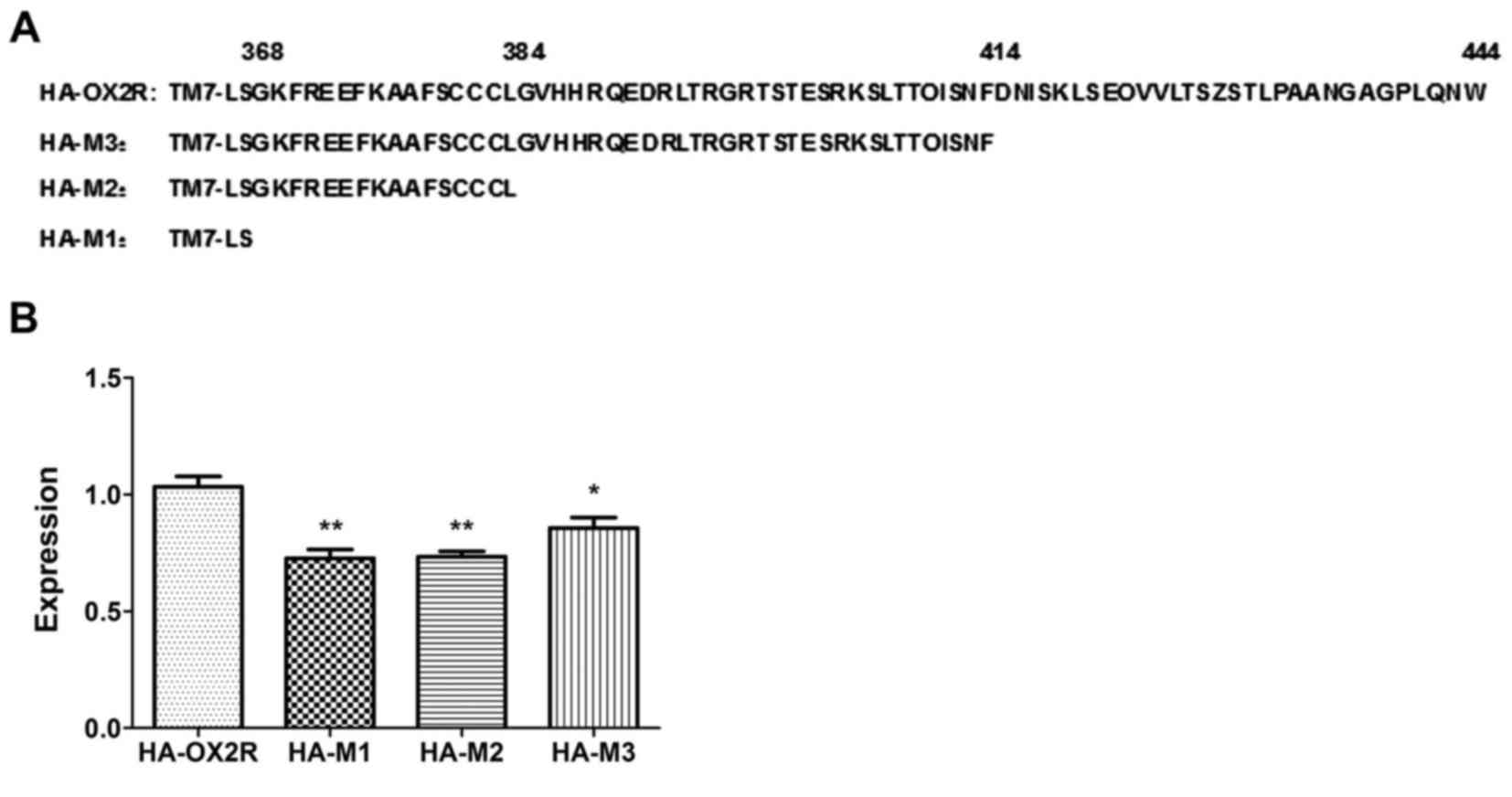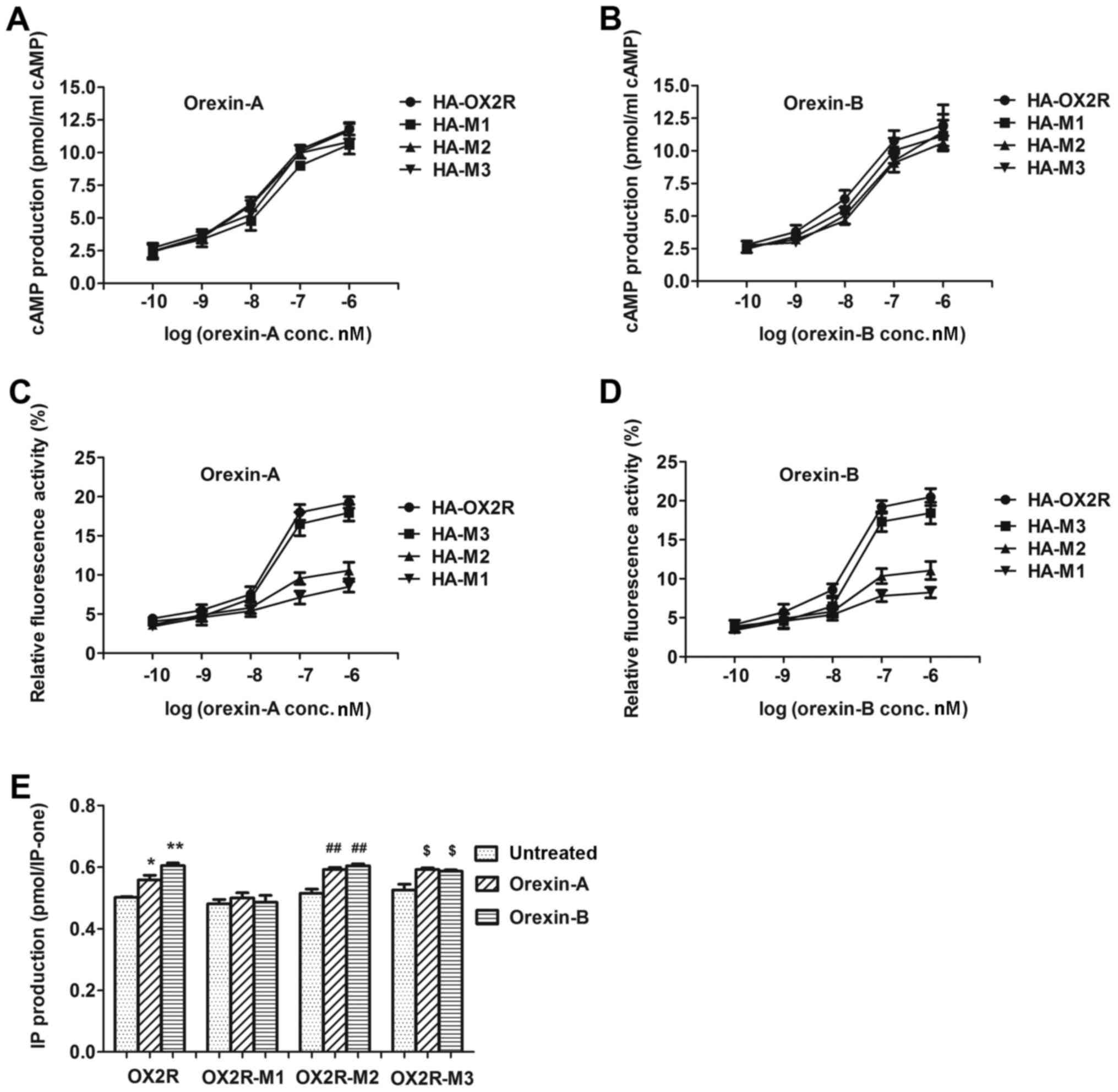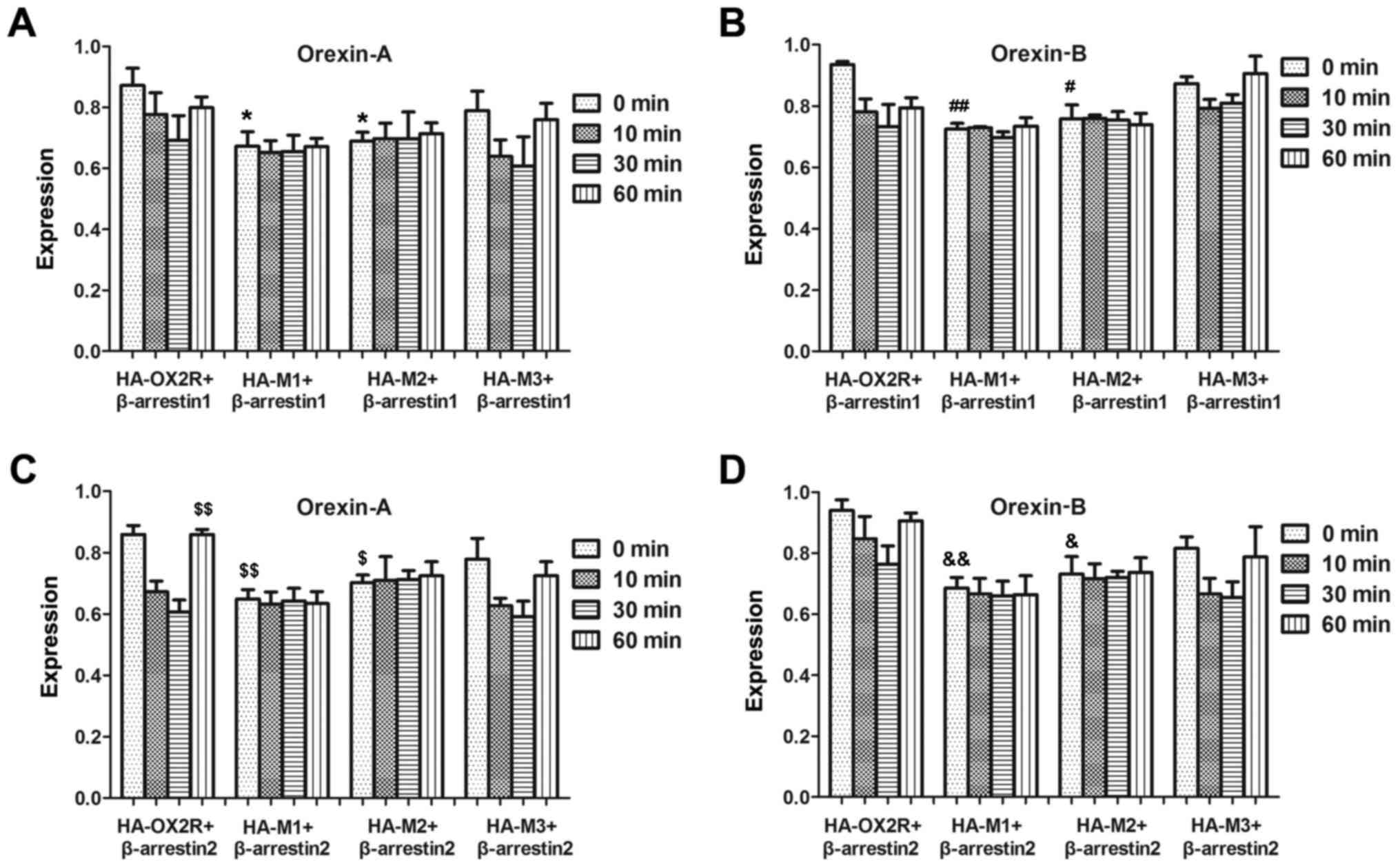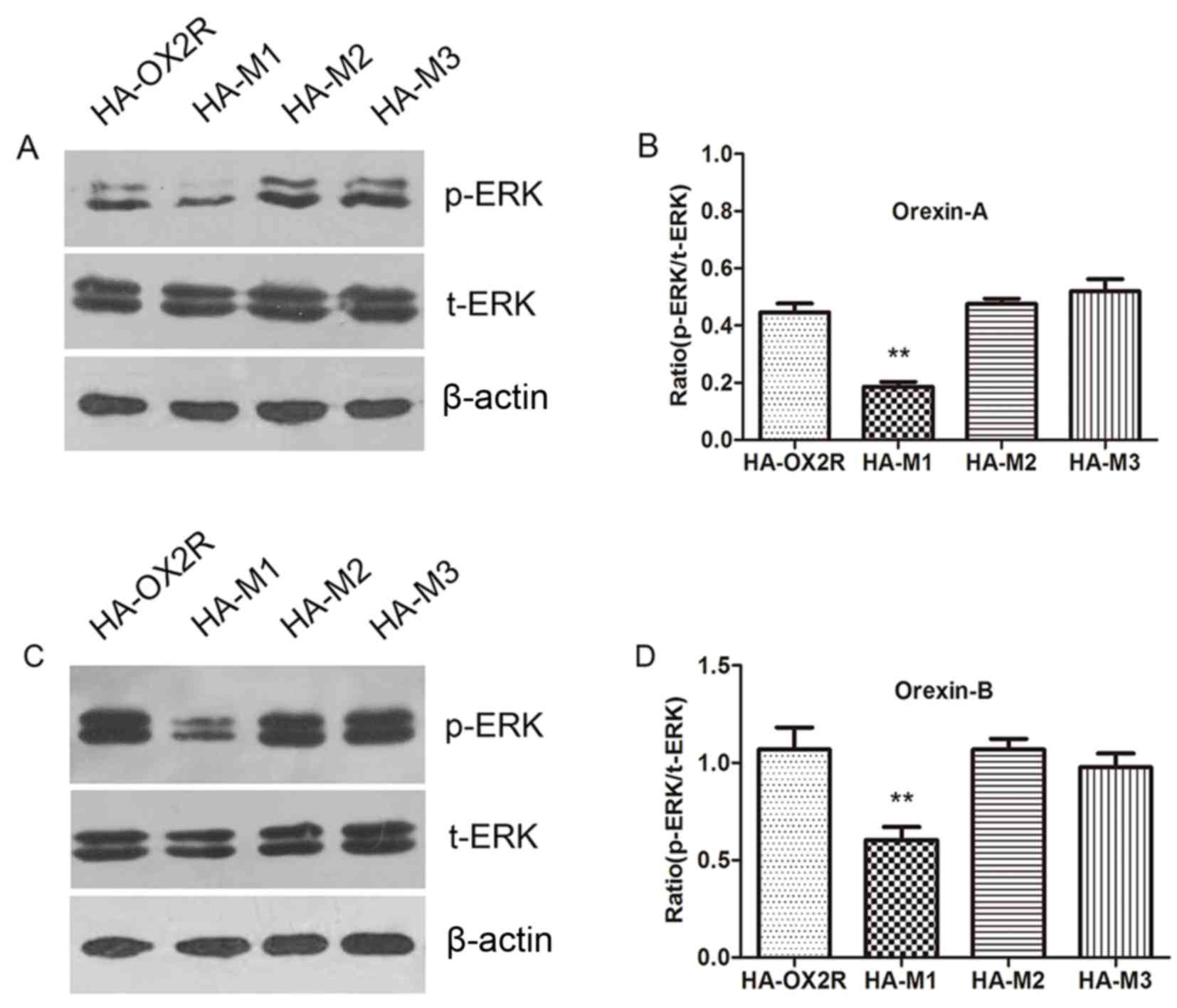|
1
|
Bockaert J and Pin JP: Molecular tinkering
of G protein-coupled receptors: An evolutionary success. Embo J.
18:1723–1729. 1999. View Article : Google Scholar : PubMed/NCBI
|
|
2
|
Croft W, Hill C, McCann E, Bond M,
Esparza-Franco M, Bennett J, Rand D, Davey J and Ladds G: A
physiologically required G protein-coupled receptor
(GPCR)-regulator of G protein signaling (RGS) interaction that
compartmentalizes RGS activity. J Biol Chem. 288:27327–27342. 2013.
View Article : Google Scholar : PubMed/NCBI
|
|
3
|
Lu ZL, Saldanha JW and Hulme EC:
Seven-transmembrane receptors: Crystals clarify. Trends Pharmacol
Sci. 23:140–146. 2002. View Article : Google Scholar : PubMed/NCBI
|
|
4
|
Wistrand M, Käll L and Sonnhammer EL: A
general model of G protein-coupled receptor sequences and its
application to detect remote homologs. Protein Sci. 15:509–521.
2006. View Article : Google Scholar : PubMed/NCBI
|
|
5
|
Fortin JP, Zhu Y, Choi C, Beinborn M,
Nitabach MN and Kopin AS: Membrane-tethered ligands are effective
probes for exploring class B1 G protein-coupled receptor function.
Proc Natl Acad Sci USA. 106:8049–8054. 2009. View Article : Google Scholar : PubMed/NCBI
|
|
6
|
Thompson A and Kanamarlapudi V: Distinct
regions in the C-Terminus required for GLP-1R cell surface
expression, activity and internalisation. Mol Cell Endocrinol.
413:66–77. 2015. View Article : Google Scholar : PubMed/NCBI
|
|
7
|
Feng Y, Liu T, Li XQ, Liu Y, Zhu XY,
Jankovic J, Pan TH and Wu YC: Neuroprotection by Orexin-A via
HIF-1α induction in a cellular model of Parkinson's disease.
Neurosci Lett. 579:35–40. 2014. View Article : Google Scholar : PubMed/NCBI
|
|
8
|
Lowther KM, Uliasz TF, Götz KR, Nikolaev
VO and Mehlmann LM: Regulation of constitutive GPR3 signaling and
surface localization by GRK2 and β-arrestin-2 Overexpression in
HEK293 cells. PLoS One. 8:e653652013. View Article : Google Scholar : PubMed/NCBI
|
|
9
|
Katsushima Y, Sato T, Yamada C, Ito M,
Suzuki Y, Ogawa E, Sukegawa I, Sukegawa J, Fukunaga K and
Yanagisawa T: Interaction of PICK1 with C-terminus of growth
hormone- releasing hormone receptor (GHRHR) modulates trafficking
and signal transduction of human GHRHR. J Pharmacol Sci.
122:193–204. 2013. View Article : Google Scholar : PubMed/NCBI
|
|
10
|
Shim JY, Ahn KH and Kendall DA: Molecular
basis of cannabinoid CB1 receptor coupling to the G protein
heterotrimer Gαiβγ: identification of key CB1 contacts with the
C-terminal helix α5 of Gαi. J Biol Chem. 288:32449–32465. 2013.
View Article : Google Scholar : PubMed/NCBI
|
|
11
|
Gandía J, Fernández-Dueñas V, Morató X,
Caltabiano G, González-Muñiz R, Pardo L, Stagljar I and Ciruela F:
The Parkinson's disease-associated GPR37 receptor-mediated
cytotoxicity is controlled by its intracellular cysteine-rich
domain. J Neurochem. 125:362–372. 2013. View Article : Google Scholar : PubMed/NCBI
|
|
12
|
Ammoun S, Holmqvist T, Shariatmadari R,
Oonk HB, Detheux M, Parmentier M, Akerman KE and Kukkonen JP:
Distinct recognition of OX1 and OX2 receptors by orexin peptides. J
Pharmacol Exp Ther. 305:507–514. 2003. View Article : Google Scholar : PubMed/NCBI
|
|
13
|
Baccari MC: Orexins and gastrointestinal
functions. Curr Protein Pept Sci. 11:148–155. 2010. View Article : Google Scholar : PubMed/NCBI
|
|
14
|
Mavanji V, Perez-Leighton CE, Kotz CM,
Kotz CM, Billington CJ, Parthasarathy S, Sinton CM and Teske JA:
Promotion of wakefulness and energy expenditure by Orexin-A in the
ventrolateral preoptic area. Sleep. 38:1361–1370. 2015. View Article : Google Scholar : PubMed/NCBI
|
|
15
|
Kannan H, Shirasaka T, Watanabe S, Yu NS,
Kuitake T and Takasaki M: Central action of orexins on sympathetic
outflow and cardiovascular function with a focus on the
paraventricular nucleus of the hypothalamus. Masui. 56:30–39.
2007.(In Japanese). PubMed/NCBI
|
|
16
|
Kaminski T and Smolinska N: Expression of
orexin receptors in the pituitary. Vitam Horm. 89:61–73. 2012.
View Article : Google Scholar : PubMed/NCBI
|
|
17
|
Tang J, Chen J, Ramanjaneya M, Punn A,
Conner AC and Randeva HS: The signalling profile of recombinant
human orexin-2 receptor. Cell Signal. 20:1651–1661. 2008.
View Article : Google Scholar : PubMed/NCBI
|
|
18
|
Kara E, Crépieux P, Gauthier C, Martinat
N, Piketty V, Guillou F and Reiter E: A phosphorylation cluster of
five serine and threonine residues in the C-terminus of the
follicle-stimulating hormone receptor is important for
desensitization but not for beta-arrestin-mediated ERK activation.
Mol Endocrinol. 20:3014–3026. 2006. View Article : Google Scholar : PubMed/NCBI
|
|
19
|
Lehmann A, Kliewer A, Schutz D, Nagel F,
Stumm R and Schulz S: Carboxyl-terminal multi-site phosphorylation
regulates internalization and desensitization of the human sst2
somatostatin receptor. Mol Cell Endocrinol. 387:44–51. 2014.
View Article : Google Scholar : PubMed/NCBI
|
|
20
|
Venkatesan S, Petrovic A, Locati M, Kim
YO, Weissman D and Murphy PM: A membrane-proximal basic domain and
cysteine cluster in the C-terminal tail of CCR5 constitute a
bipartite motif critical for cell surface expression. J Biol Chem.
276:40133–40145. 2001. View Article : Google Scholar : PubMed/NCBI
|
|
21
|
Tetsuka M, Saito Y, Imai K, Doi H and
Maruyama K: The basic residues in the membrane-proximal C-terminal
tail of the rat melanin-concentrating hormone receptor 1 are
required for receptor function. Endocrinology. 145:3712–3723. 2004.
View Article : Google Scholar : PubMed/NCBI
|
|
22
|
Blomenröhr M, Heding A, Sellar R, Leurs R,
Bogerd J, Eidne KA and Willars GB: Pivotal role for the cytoplasmic
carboxyl-terminal tail of a nonmammalian gonadotropin-releasing
hormone receptor in cell surface expression, ligand binding, and
receptor phosphorylation and internalization. Mol Pharmacol.
56:1229–1237. 1999.PubMed/NCBI
|
|
23
|
Estall JL, Koehler JA, Yusta B and Drucker
DJ: The glucagon-like peptide-2 receptor C terminus modulates
beta-arrestin-2 association but is dispensable for ligand-induced
desensitization, endocytosis, and G-protein-dependent effector
activation. J Biol Chem. 280:22124–22134. 2005. View Article : Google Scholar : PubMed/NCBI
|
|
24
|
Innamorati G, Giannone F, Guzzi F, Rovati
GE, Accomazzo MR, Chini B, Bianchi E, Schiaffino MV, Tridente G and
Parenti M: Heterotrimeric G proteins demonstrate differential
sensitivity to beta-arrestin dependent desensitization. Cell
Signal. 21:1135–1142. 2009. View Article : Google Scholar : PubMed/NCBI
|
|
25
|
Golan M, Schreiber G and Avissar S:
Antidepressants, beta-arrestins and GRKs: From regulation of signal
desensitization to intracellular multifunctional adaptor functions.
Curr Pharm Des. 15:1699–1708. 2009. View Article : Google Scholar : PubMed/NCBI
|
|
26
|
Chaki S, Guo DF, Yamano Y, Ohyama K, Tani
M, Mizukoshi M, Shirai H and Inagami T: Role of carboxyl tail of
the rat angiotensin II type 1A receptor in agonist-induced
internalization of the receptor. Kidney Int. 46:1492–1495. 1994.
View Article : Google Scholar : PubMed/NCBI
|
|
27
|
Willars GB, Heding A, Vrecl M, Sellar R,
Blomenröhr M, Nahorski SR and Eidne KA: Lack of a C-terminal tail
in the mammalian gonadotropin-releasing hormone receptor confers
resistance to agonist-dependent phosphorylation and rapid
desensitization. J Biol Chem. 274:30146–30153. 1999. View Article : Google Scholar : PubMed/NCBI
|
|
28
|
Neuschäfer-Rube F, Hermosilla R, Rehwald
M, Rönnstrand L, Schülein R, Wernstedt C and Püschel GP:
Identification of a Ser/Thr cluster in the C-terminal domain of the
human prostaglandin receptor EP4 that is essential for
agonist-induced beta-arrestin1 recruitment but differs from the
apparent principal phosphorylation site. Biochem J. 379:573–585.
2004. View Article : Google Scholar : PubMed/NCBI
|
|
29
|
Qiu Y, Loh HH and Law PY: Phosphorylation
of the delta-opioid receptor regulates its beta-arrestins
selectivity and subsequent receptor internalization and adenylyl
cyclase desensitization. J Biol Chem. 282:22315–22323. 2007.
View Article : Google Scholar : PubMed/NCBI
|
|
30
|
Liu Q, Dewi DA, Liu W, Bee MS and
Schonbrunn A: Distinct phosphorylation sites in the SST2A
somatostatin receptor control internalization, desensitization, and
arrestin binding. Mol Pharmacol. 73:292–304. 2008. View Article : Google Scholar : PubMed/NCBI
|
|
31
|
Conchon S, Barrault MB, Miserey S, Corvol
P and Clauser E: The C-terminal third intracellular loop of the rat
AT1A angiotensin receptor plays a key role in G protein coupling
specificity and transduction of the mitogenic signal. J Biol Chem.
272:25566–25572. 1997. View Article : Google Scholar : PubMed/NCBI
|
|
32
|
Conner M, Hicks MR, Dafforn T, Knowles TJ,
Ludwig C, Staddon S, Overduin M, Günther UL, Thome J and Wheatley
M: Functional and biophysical analysis of the C-terminus of the
CGRP-receptor; a family B GPCR. Biochemistry. 47:8434–8444. 2008.
View Article : Google Scholar : PubMed/NCBI
|













